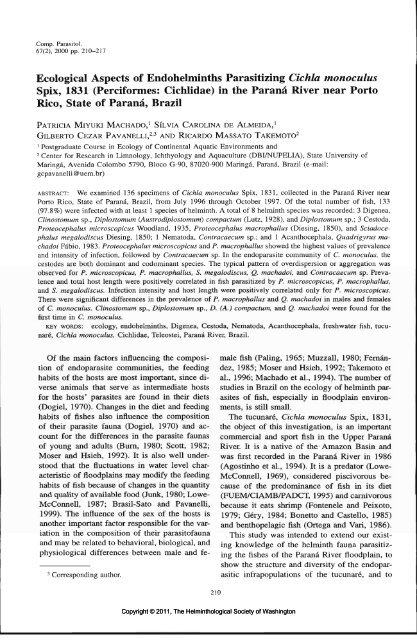Comparative Parasitology 67(2) 2000 - Peru State College
Comparative Parasitology 67(2) 2000 - Peru State College
Comparative Parasitology 67(2) 2000 - Peru State College
Create successful ePaper yourself
Turn your PDF publications into a flip-book with our unique Google optimized e-Paper software.
Comp. Parasitol.<br />
<strong>67</strong>(2), <strong>2000</strong> pp. 210-217<br />
Ecological Aspects of Endohelminths Parasitizing Cichla monoculus<br />
Spix, 1831 (Perciformes: Cichlidae) in the Parana River near Porto<br />
Rico, <strong>State</strong> of Parana, Brazil<br />
PATRICIA MIYUKI MACHADO,1 SILVIA CAROLINA DE ALMEIDA,1<br />
GlLBERTO CEZAR PAVANELLI,2'3 AND RlCARDO MASSATO TAKEMOTO2<br />
1 Postgraduate Course in Ecology of Continental Aquatic Environments and<br />
2 Center for Research in Limnology, Ichthyology and Aquaculture (DBI/NUPELIA), <strong>State</strong> University of<br />
Maringa, Avenida Colombo 5790, Bloco G-90, 87020-900 Maringa, Parana, Brazil (e-mail:<br />
gcpavanelli@uem.br)<br />
ABSTRACT: We examined 136 specimens of Cichla monoculus Spix, 1831, collected in the Parana River near<br />
Porto Rico, <strong>State</strong> of Parana, Brazil, from July 1996 through October 1997. Of the total number of fish, 133<br />
(97.8%) were infected with at least 1 species of helminth. A total of 8 helminth species was recorded: 3 Digenea,<br />
Clinostomum sp., Diplostomum (Austrodiplostomuni) compactum (Lutz, 1928), and Diplostomum sp.; 3 Cestoda,<br />
Proteocephalus microscopicus Woodland, 1935, Proteocephalus rnacrophallus (Diesing, 1850), and Sciadocephalus<br />
megalodiscus Diesing, 1850; 1 Nematoda, Contracaecum sp.; and 1 Acanthocephala, Quadrigyrus machadoi<br />
Fabio, 1983. Proteocephalus microscopicus and P. macrophallus showed the highest values of prevalence<br />
and intensity of infection, followed by Contracaecum sp. In the endoparasite community of C. monoculus, the<br />
cestodes are both dominant and codominant species. The typical pattern of overdispersion or aggregation was<br />
observed for P. microscopicus, P. macrophallus, S. megalodiscus, Q. machadoi, and Contracaecum sp. Prevalence<br />
and total host length were positively correlated in fish parasitized by P. microscopicus, P. macrophallus,<br />
and S. megalodiscus. Infection intensity and host length were positively correlated only for P. microscopicus.<br />
There were significant differences in the prevalence of P. macrophallus and Q. machadoi in males and females<br />
of C. monoculus. Clinostomum sp., Diplostomum sp., D. (A.) compactum, and Q. machadoi were found for the<br />
first time in C. monoculus.<br />
KEY WORDS: ecology, endohelminths, Digenea, Cestoda, Nematoda, Acanthocephala, freshwater fish, tucunare,<br />
Cichla monoculus, Cichlidae, Teleostei, Parana River, Brazil.<br />
Of the main factors influencing the composition<br />
of endoparasite communities, the feeding<br />
habits of the hosts are most important, since diverse<br />
animals that serve as intermediate hosts<br />
for the hosts' parasites are found in their diets<br />
(Dogiel, 1970). Changes in the diet and feeding<br />
habits of fishes also influence the composition<br />
of their parasite fauna (Dogiel, 1970) and account<br />
for the differences in the parasite faunas<br />
of young and adults (Burn, 1980; Scott, 1982;<br />
Moser and Hsieh, 1992). It is also well understood<br />
that the fluctuations in water level characteristic<br />
of floodplains may modify the feeding<br />
habits of fish because of changes in the quantity<br />
and quality of available food (Junk, 1980; Lowe-<br />
McConnell, 1987; Brasil-Sato and Pavanelli,<br />
1999). The influence of the sex of the hosts is<br />
another important factor responsible for the variation<br />
in the composition of their parasitofauna<br />
and may be related to behavioral, biological, and<br />
physiological differences between male and fe-<br />
3 Corresponding author.<br />
210<br />
Copyright © 2011, The Helminthological Society of Washington<br />
male fish (Paling, 1965; Muzzall, 1980; Fernandez,<br />
1985; Moser and Hsieh, 1992; Takemoto et<br />
al., 1996; Machado et al., 1994). The number of<br />
studies in Brazil on the ecology of helminth parasites<br />
of fish, especially in floodplain environments,<br />
is still small.<br />
The tucunare, Cichla monoculus Spix, 1831,<br />
the object of this investigation, is an important<br />
commercial and sport fish in the Upper Parana<br />
River. It is a native of the Amazon Basin and<br />
was first recorded in the Parana River in 1986<br />
(Agostinho et al., 1994). It is a predator (Lowe-<br />
McConnell, 1969), considered piscivorous because<br />
of the predominance of fish in its diet<br />
(FUEM/CIAMB/PADCT, 1995) and carnivorous<br />
because it eats shrimp (Fontenele and Peixoto,<br />
1979; Gery, 1984; Bonetto and Castello, 1985)<br />
and benthopelagic fish (Ortega and Vari, 1986).<br />
This study was intended to extend our existing<br />
knowledge of the helminth fauna parasitizing<br />
the fishes of the Parana River floodplain, to<br />
show the structure and diversity of the endoparasitic<br />
infrapopulations of the tucunare, and to

















